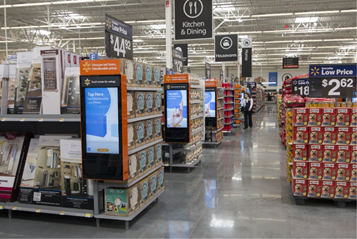How Customer Churn is a Major Impediment for Business Growth–Part 2: Endless Aisle
What is Endless Aisle?
Endless aisle is a retail business model that enables retailers to provide customers with options to explore and buy items across multiple channels like online and in-store. It makes the store’s aisles ”endless”, and provides a range of enticing options including unavailable options in store. This increases the likelihood of customers making a purchase. Endless aisle is enabled by a digital storefront that displays the products and is accessible both online and at the store. Some examples of how retailers have executed endless aisle include in-store kiosks, digital displays, augmented reality (AR) mobile apps, etc.
Purchased products can be fulfilled either directly or by pickup at a physical store, seamlessly connecting both the physical and digital realms of the retailer. The endless aisle in retail is perfect for fulfilling products that are:
- Out-of-stock
- On backorder
- New
- Special release
Retailers should have a holistic strategy of when to use this model and what benefits they can reap from the “endless aisle” strategy.
Why Do Retailers Need to Use Endless Aisle?
Retailers have the constant business challenge of addressing customer churn. Customer churn is defined as the phenomenon of businesses losing customers. It leads to depressed sales and disengaged user experience. In addition, the pandemic has accelerated the shift to online shopping. Hence, e-commerce has taken center stage. Customers can easily shift to a competitor if they do not get a good experience. Endless aisle in retail can provide a better customer experience and retain customers. Thus, it is becoming a popular and effective retailer strategy to address customer churn.
Endless Aisle Surmounts Retailer Challenges
Modern retailers face several challenges and constraints when they operate in only one space – the digital realm or the physical realm. The endless aisle strategy helps blend customer experiences across channels and ensures customers are satisfied, surmounting many of these constraints. Some of the challenges are:
- Customers being disappointed when products have been out of stock in stores.
- Customers being unable to get the exact product they want – a particular variant or size.
- Customers being unable to get products when they want.
- Customers, when shopping online, have struggled with too much information and been unable to decide what to buy.
- Retail associates have struggled with providing customers with enough information to help with decision-making.
Blending ecommerce with a brick-and-mortar shop environment ensures that the online and the in-store channels are connected, thus bringing all the available products to the in-store customer. This helps alleviate some of the challenges.
Factors to Consider When Retailers Implement Endless Aisle
The endless aisle strategy is not merely slapping a digital facade over the physical storefront. It opens a gamut of opportunities and challenges. It needs careful planning, especially in the merchandising and order management systems as well as technological considerations and data analytics. As retailers embark on their journey to adopt endless aisle, there are a few critical aspects to consider.
1. Connecting Supply Chains
Retailers need to connect each of their supply chains. Aggregating orders from different supply chains gives customers a single access point to all products across multiple fulfilment channels. Retailers also need to have an easy-to-use digital dashboard that gives a view of cross-channel inventory and helps auto-route orders. The distribution centers and stores also need to be able to handle orders across multiple channels to deliver to customers based on customer needs.
Retailers need to auto-route orders to the appropriate channel for customers based on the following factors:
- Stock location
- Stock inventory amount
- Broken, lost, or stolen good replacements
- Online returns
2. Real-Time Product Availability
Retailers need to have clear stock visibility for endless aisle to be effective. Inventory must be updated regularly in real-time to meet order fulfilment across all the retailer’s sales channels. Cloud-based endless aisle software relies on real-time data.
3. Staff Confidence
Retailers must ensure that associates are confident that the inventory levels they access are accurate – either on the point-of-sale screen or the customer-facing screen, to ensure order fulfillment.
4. Multichannel Order Management
For visibility of stock inventory levels across channels, multiple systems must be integrated. An effective order management system can help with fulfilment of orders across multiple supply chains, distribution centers and stores. This requires managing inventory from a centralized system to provide visibility on stock, pricing, fulfilment methods and costs to associates and customers. In most cases, this requires updating existing merchandising systems like stock order management, warehouse management, pricing systems and promotion planning systems.
5. Tracking and Notifications
With multiple fulfillment methods like locker, etc., it is critical to track and notify customers. Order tracking and notification updates help customers track orders in real-time. This experience should be prioritized across touchpoints for the best experience.
Benefits of Endless Aisle
Adopting the endless aisle model in retail provides retailers with significant benefits:
1. Save Sales and Maximize Margins
Endless aisle helps engage customers that would have left without making a purchase, thus saving sales that would have been lost. The endless aisle model helps retailers increase customer retention and their lifetime value (LTV) thus reducing customer acquisition costs. In addition, the endless aisle strategy also helps increase margins, enabling order fulfillment by mapping a product through more efficient supply chains and fulfilment modes.
2. Deeper Customer Insights
Endless aisle eliminates informational silos. Capturing an online transaction across different merchandising systems and different channels creates a single, in-depth view of the customer. Data analytics helps gain deeper insights into customers, identifies customer segments, and customizes experiences and operations relevant to the customer segments.
Walmart Implemented Endless Aisle for Effective Store Product Mix
Walmart, one of the largest US retailers, implemented an endless aisle strategy by placing interactive kiosks at the end of each aisle. They allow in-store customers to browse for in-store and out-of-stock items. Once added to a virtual cart, the kiosk prints out a receipt for the customer to pay at checkout. The customer gets notified when their order is ready for pickup. Walmart incentivizes customers to use the kiosk by giving a 10% discount on these orders. This endless aisle strategy has major benefits for Walmart, one of them being a reduction in stock-keeping units (SKUs).

Source: Walmart Endless Aisle / Nuno Boggiss
Conclusion
Endless aisle has been a great disruptor for the retail industry leading to a blending of the digital and physical retail space. This has led to several new customer experiences and reduced customer churn. The pandemic has accelerated adoption of endless aisle and it will become a norm in the years to come. Now more than ever, retailers must pivot quickly to adopt endless aisle.
References
Experience is everything: Here’s how to get it right (pwc.com)
Five reasons endless aisle is the future of retail – Insights | Worldpay from FIS (fisglobal.com)
More from Padma Ravi
In the rapidly evolving landscape of artificial intelligence (AI), prompt engineering has emerged…
What is customer churn? Customer churn refers to the phenomenon of businesses or organizations…
Today brand managers and advertisers plan and spend their advertising budget by looking at…
From Second Life (a technology developed by Linden Lab that allowed people to create an avatar…
Latest Blogs
Core banking platforms like Temenos Transact, FIS® Systematics, Fiserv DNA, Thought Machine,…
We are at a turning point for healthcare. The complexity of healthcare systems, strict regulations,…
Clinical trials evaluate the efficacy and safety of a new drug before it comes into the market.…
Introduction In the upstream oil and gas industry, drilling each well is a high-cost, high-risk…




